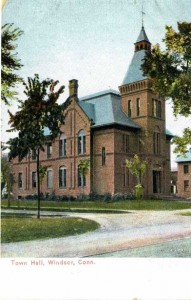By Steve Thornton
Several farm workers entered Windsor Town Hall, following Erwyn Glanz, the elected town constable and Democratic party member, who had given them a ride. Most likely, this was the first time the workers had ever been to the Broad Street building, a cramped space with narrow halls and bulletin boards plastered with notices. Soon, they would be swept up into a political face-off between the town’s Republican and Democratic party officials.
The men were there to register to vote. It was October 1956 and Connecticut’s congressional elections were fast approaching. The farm hands hailed from Puerto Rico but were presently living at Camp Windsor, a local migrant workers’ barracks where seasonal laborers were required to stay.

Postcard Town Hall, Windsor, Conn. – Windsor Historical Society, Windsor
If they had been living on their home island, the men would not have been able to vote in the upcoming US Senate and House elections. Although Congress had granted citizenship to Puerto Ricans in 1917, the only way these citizens could use their franchise by law was if they resided in the United States. (Puerto Rico had been a colony of Spain until 1898, when, as part of the treaty ending the Spanish-American War, the US assumed sovereignty. Puerto Rico’s legislature voted unanimously in 1917 against the limited citizenship offered in the measure but had no direct say in the congressional outcome.)
Ten workers passed the board of admission requirements and registered to vote, but local Republican Party members soon questioned whether all of the men did indeed meet the necessary requirements specified by state law. Not only did they need to have lived in the United States for at least 12 months (with 6 or more months of that time as Windsor residents), they were also subject to passing a literacy test. Such tests, though legal in some states at that time, often served as means by which to bar certain populations from the voting booth.
Literacy Tests Not Confined to Jim Crow South
Since 1855, Connecticut’s state constitution had required adults to pass a literacy test and a one-year residency rule in order to qualify as a voter. Connecticut was the first state to require a literacy test, to keep Irish immigrants from voting. Southern states adopted the tactic after Reconstruction. Citing an old English legal principle, literacy test promoters argued that if a person was not sufficiently educated, his vote could be too easily manipulated. To opponents, literacy tests constituted a legal means to disenfranchising minorities and other “undesirables.”
In theory, the literacy requirement applied to every citizen. In practice, however, officials in charge of voter registration could administer the test at their discretion, which resulted in a discriminatory singling out of African Americans, the poor, and other groups. By the 1950s, the Land of Steady Habits was one of only 12 states that still used literacy tests; this kept the door open to their use as instruments for intimidating or disenfranchising would-be voters. Dr. Martin Luther King Jr. called literacy tests vicious and undemocratic.
Disputed Eligibility Debated at Town Meeting and Decided in Superior Court
After the men registered as electors with the Democratic Party, Windsor’s Republican officials alleged that the town clerk (a democrat) had sworn the men in behind closed doors after expelling the Republican registrar of voter’s from the room when she protested that the men did not meet the eligibility requirements. The town clerk and Democratic registrar disputed this account. In an open letter published in the local paper, The News-Weekly, they claimed that “at no time were closed door proceedings held.” Furthermore, they maintained that two Republican officials had observed the applicants’ reading tests without complaint. Each side characterized the other as resorting to political machinations that favored their own party.
A public hearing was called to sort out the matter of the men’s eligibility. Roughly 200 people packed town hall. During the proceedings, local Democratic attorney Charles Mahoney suggested that race prejudice was behind the controversy. According the Hartford Courant, Mahoney “declared that the Republicans were persecuting the minority groups.” The account goes on to note that the opposition’s counsel, Republican National Committeeman H. Meade Alcorn, laughed, “Charley, you don’t really believe that.” The crowd “roared” with laughter and Mahoney, who reportedly “laughed too” sat down.
Ultimately, the Republican party took the matter to Connecticut Superior Court. There, the Puerto Rican men again took a literacy test. Judge Frank J. Covello found three of the 10 men qualified to vote. He advised that the remaining seven be stricken from the voters’ list: five because they did not meet residency requirements, one for failure to appear in court, and one for not meeting the literacy requirements. Covello did note that two of the seven men would soon meet the residency requirements and could reapply before the November 6 election.
Silences in Coverage
Coverage of the events by the Windsor and Hartford papers did not record the perspectives of the 10 workers, particularly those who were, or would soon be, eligible to vote. Likewise, the reports did not call the legitimacy of literacy tests into question. That task would be left to activists in the decades to come. When the Connecticut literacy test restriction was finally eliminated, the change didn’t come from a state referendum. Instead, in 1970, civil rights advocates finally succeeded in banning the tests by amending the 1965 federal Voting Rights Act. Windsor and other towns across the state held their first-ever voter registration session without the possibility of administering literacy tests on July 16, 1970.
Steve Thornton has been a labor union organizer for 35 years and writes on the history of working people.
A version of this article originally appeared on ShoeLeatherHistoryProject.com









